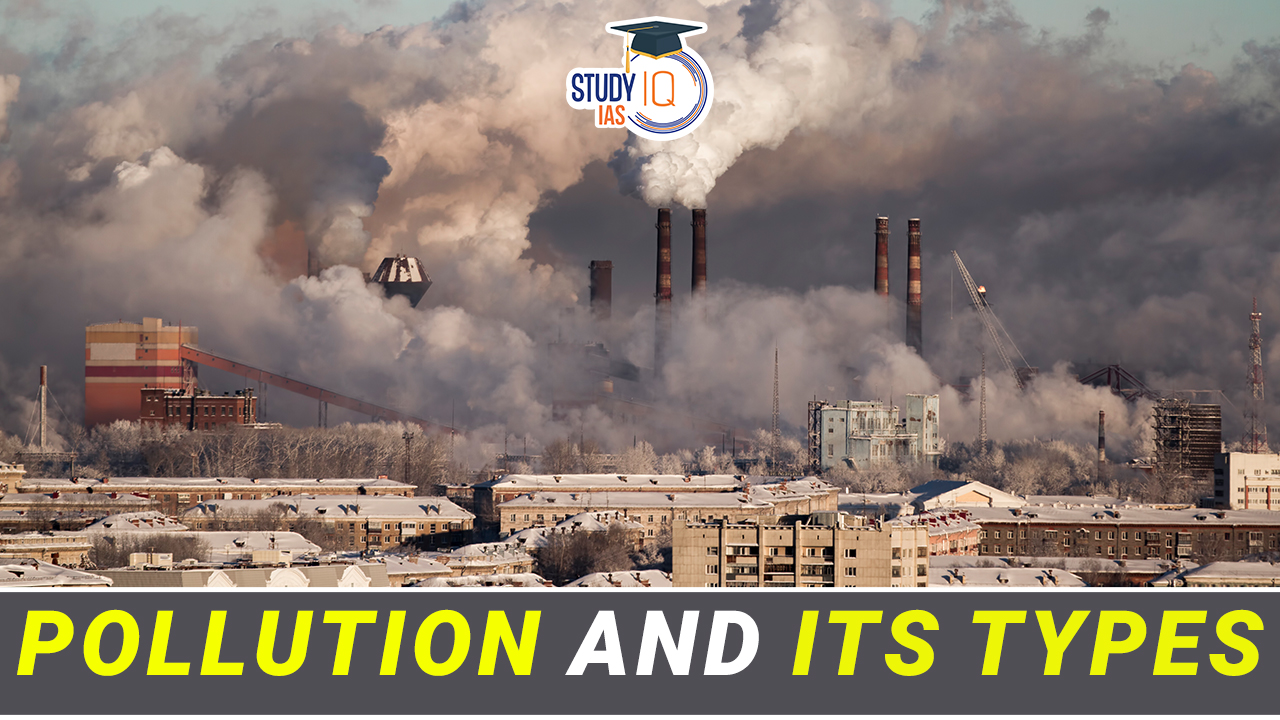Table of Contents
Pollution is the accumulation of contaminants in the environment that is harmful to humans, the environment, and natural resources. The environment is what surrounds an organism and is made up of various elements that support life, such as air, water, land, soil, etc. For the organism to thrive, these basic components must exist in a certain proportion and keep the environment in a rhythmic balance. There are several different categories of pollution, including air, water, soil, noise, land, thermal, and light pollution. Check the detailed article on Pollution and Its Types.
Any unfavorable modification or alteration in this ratio of the biological components constitutes pollution. Physical, economic, and social emergencies are caused by numerous types of pollution that result from rising pollution levels. The essential characteristics of pollution, including its types, causes, effects, and control measures will be highlighted in this article.
What is Pollution?
The biological elements of the planet are contaminated by pollution, which has a negative effect on typical ecological processes. Pollution is defined as any unnatural and harmful changes in any dimension (such as the physical, chemical, and biological aspects of any ecosystem component) that have the potential to have dangerous repercussions on a variety of life forms and property.
One of the main problems facing civilization is pollution, which affects both people and other living things and is getting worse every day. Human activities harm the environment because they contaminate the soil we use to grow plants, the water we drink, and the air we breathe.
Types of Environmental Pollution
There are primarily 7 types of pollution that can arise on Earth. The sources, impacts, and preventative actions for each of the pollution categories mentioned in this article are detailed below.
Air Pollution
Air pollution is brought on by several pollutants, including carbon monoxide, chlorofluorocarbons (CFCs), dust, mold spores, nitrogen oxides, pollen, and sulfur dioxide. Gases and solid particles in the atmosphere contribute to air pollution. In communities, hazardous gases are also produced through the use of coal, dry grass, dry farm waste, and leaves as home fuels. Some additional sources of Air Pollution are:
- Automobile pollution
- Burning of garbage
- Decayed plants and animals
- Indoor air pollution
- Industrial air pollution
- Radioactive elements.
The main impacts of air pollution are disorders of the lungs and respiratory systems and an increase in the risk of heart disease in people. Additionally, it might cause bronchitis and asthma. The environment may also be impacted since it produces more greenhouse emissions. To reduce air pollution, households and businesses should run on better-designed machinery and smokeless fuels.
- To keep the ecosystem in balance and control the impact of the rising greenhouse gases, afforestation—the planting of additional trees—should be promoted.
- The National Ambient Air Quality Standards (NAAQS) and the National Air Quality Monitoring Program (NAMP) are two more actions the government took to reduce air pollution.
Water Pollution
When hazardous substances, such as chemical contaminants, untreated waste discharges, and sewage, are dumped into rivers, lakes, and seas, water pollution results. Farming practices that use excessive amounts of fertilizers and pesticides, which can harm water bodies, are among the origins of water pollution. Environmental Pollution of water has the following causes:
- Agricultural pollutants are dumped into the water bodies.
- Disposal of radioactive substances into seawater.
- Industrial effluents enter oceans.
- Trading of marine.
- Offshore oil rigs.
- Recreational sports.
- Sewage is disposed of into the sea by rivers.
When the amount of mercury in the water grows, water pollution has the potential to lead to both dropsy illness in fish and Minamata disease in people. Additionally, it causes eutrophication (an oversupply of nutrients) and biological amplification (an increase in the concentration of harmful substances).
By changing the methods used to prevent water pollution from the environment, water usage must be controlled or decreased. For reuse, wastewater needs to undergo thorough treatment.
Soil Pollution
When levels of pollutants or harmful compounds rise and build up on the soil surface, it results in environmental pollution of the soil. Salinity and decreased soil fertility are two impacts of soil contamination. Drains become blocked as a result, which causes the release of unpleasant scents and gases. The contaminants that cause soil pollution are:
- Inorganic ions and metals
- Salts (e.g., carbonates, nitrates, phosphates, sulfates)
- Organic compounds (such as alcohols, DNA, fatty acids, hydrocarbons, lipids, proteins, PAHs, etc.).
We need to cease using plastic if we want to reduce soil pollution. To prevent soil pollution, plastic use should be decreased, and sewage should be properly treated before being used as fertilizer on planted areas.
Thermal Pollution
Thermal pollution is the loss of water quality caused by any procedure that raises the temperature of the water around it. Thermal pollution is the loss of water quality caused by any procedure that raises the temperature of the water around it.
When industrial enterprises and power plants use water as a coolant, environmental contamination results. Some of the sources of thermal pollution are industrial boilers, coal-fired power plants, oil refineries, nuclear and electric power plants, and steel-melting companies.
The repercussions of thermal pollution include a reduction in the amount of dissolved oxygen in the water, the extinction of numerous fish and invertebrate species, and the destruction of their eggs that have been laid in the water bodies.
There are certain scientific methods for preventing thermal environmental pollution, such as building cooling ponds or buildings and creating artificial lakes. These lakes are created by humans and offer a potential substitute for natural water supplies for cooling power plants.
Noise Pollution
Unwanted sound, or noise pollution, causes excruciating ear agony. Decibels (dB) are used to measure sound levels; noise levels about 90 dB produce auricular weakening, while sound levels beyond 100 dB might result in permanent hearing loss. The sound of the ship’s water contributes to noise pollution by interfering with whales’ ability to navigate and even destroying aquatic animals.
- The machinery in the industries makes noises like grinding and thunder.
- This kind of pollution is brought on by exploding rocks and soil, drilling tube wells, large earth-moving equipment, and ventilation fans at construction sites.
- The loud sound of loudspeakers and the horns on cars are other sources of this environmental pollution.
Noise pollution can lead to high blood pressure, stress-related illnesses, speech impediment, hearing loss, unbalanced sleep patterns, and decreased productivity.
By keeping roadside cars in good condition and employing soundproof technology in busy areas, noise pollution can be reduced. Horn usage on roads should be kept to a minimum. Silencers must be installed on industrial machinery and automobiles to prevent excessive noise.
Light Pollution
Light pollution, also known as photo pollution and frequently seen in urban areas, is caused by the additional light in the night sky. Because it ruins the ecology, this kind of environmental pollution makes it difficult to discern between day and night.
Artificial indoor or outdoor light, street lighting, display and advertisement lighting, security lights, luminous athletic arenas, etc. are the culprits. The effects of light pollution on ecosystems, the night sky, astronomical research, astronomical observations, energy waste, and the health of living things are all negative.
Light pollution has an adverse effect on wildlife rhythms, increases carbon dioxide levels, disrupts sleep cycles, and distorts the appearance of stars in the night sky. Control Measures for light pollution are:
- Lights should be turned off whenever unused, especially at night.
- The overutilization of indoor lights should be minimized.
- Lights should be pointed towards the ground whenever you are going outside your home.
Radioactive Pollution
The deposition or introduction of radioactive materials into an environment when their presence is unplanned or the levels of radioactivity are unwanted is known as radioactive contamination. Due to the ionizing radiation it emits, this kind of pollution is dangerous to human health. Radiation of this kind has enough power to harm DNA in genes and cells. Radioactivity can occur in one of two ways:
- Naturally occurring radioactivity
- Man-made radioactivity
One of the most infamous cases that resulted in radioactive pollution was the Chernobyl disaster. Other examples include:
- Fukushima Daiichi Nuclear Disaster
- Nuclear fallout (after atmospheric nuclear explosions)
- Criticality accidents
Effects of Environmental Pollution
All living things are susceptible to the dangers of environmental contamination. Wheezing, coughing, respiratory problems, and other conditions can all be brought on by air pollution. It can also irritate the skin, nose, and throat.
- Asthma, heart attacks, and other respiratory issues can all be brought on by air pollution.
- Acid rain, ozone layer degradation, and global warming are further effects of air pollution.
- When consumed by people, environmental pollution of water can kill aquatic life and possibly result in diseases like typhoid and jaundice.
- Water that has been contaminated has very little dissolved oxygen (DO), making it unsafe to consume.
- The quality of plants cultivated can be impacted by soil or land contamination, which might interfere with the subsurface life of microorganisms.
Environmental Pollution Control Measures
Different types of environmental contamination can be controlled by implementing some appropriate actions. For the protection of people and other living things, pollution management is necessary.
- Given that plastic takes years to disintegrate in the ecosystem, its usage should be outlawed.
- Both interior and outdoor lighting should not be used needlessly.
Crackers ought to be prohibited since they significantly harm the environment. - Reusable materials can help reduce environmental pollution, and they should be vigorously promoted and recycled for use in the future.
- More people should choose public transportation because it consumes less energy and gas.
- Since fans consume less electricity and energy to run, they should be used more frequently than air conditioners.


 Phone-tapping in India, Legal Framework ...
Phone-tapping in India, Legal Framework ...
 Jharkhand High Court Assistants Admit Ca...
Jharkhand High Court Assistants Admit Ca...





















